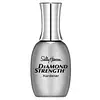What's inside
What's inside
 Key Ingredients
Key Ingredients

 Benefits
Benefits

No benefits
 Concerns
Concerns

 Ingredients Side-by-side
Ingredients Side-by-side

Butyl Acetate
MaskingEthyl Acetate
PerfumingAlcohol Denat.
AntimicrobialNitrocellulose
Isopropyl Alcohol
SolventButyl Acetate, Ethyl Acetate, Alcohol Denat., Nitrocellulose, Isopropyl Alcohol, Adipic Acid/Neopentyl Glycol/Trimellitic Anhydride Copolymer, Triphenyl Phosphate, Trimethyl Pentanyl Diisobutyrate, Sucrose Acetate Isobutyrate, Etocrylene, Dimethicone, Isopropyl Titanium Triisostearate, Diamond Powder, CI 60725
Ethyl Acetate
PerfumingButyl Acetate
MaskingAlcohol Denat.
AntimicrobialNitrocellulose
Adipic Acid/Neopentyl Glycol/Trimellitic Anhydride Copolymer
Isopropyl Alcohol
SolventTrimethyl Pentanyl Diisobutyrate
Triphenyl Phosphate
Camphor
MaskingSucrose Benzoate
Acrylates Copolymer
Etocrylene
UV AbsorberWater
Skin ConditioningButylene Glycol
HumectantHydrolyzed Wheat Protein
Skin ConditioningSaccharide Isomerate
HumectantSaccharomyces/Zinc Ferment
Skin ConditioningSaccharomyces/Calcium Ferment
Skin ConditioningSaccharomyces/Copper Ferment
Skin ConditioningTocopheryl Acetate
AntioxidantTosylamide/Epoxy Resin
Dimethicone
EmollientAscorbic Acid
AntioxidantSilica
AbrasiveCI 60725
Cosmetic ColorantAmyl Acetate
MaskingEthyl Acetate, Butyl Acetate, Alcohol Denat., Nitrocellulose, Adipic Acid/Neopentyl Glycol/Trimellitic Anhydride Copolymer, Isopropyl Alcohol, Trimethyl Pentanyl Diisobutyrate, Triphenyl Phosphate, Camphor, Sucrose Benzoate, Acrylates Copolymer, Etocrylene, Water, Butylene Glycol, Hydrolyzed Wheat Protein, Saccharide Isomerate, Saccharomyces/Zinc Ferment, Saccharomyces/Calcium Ferment, Saccharomyces/Copper Ferment, Tocopheryl Acetate, Tosylamide/Epoxy Resin, Dimethicone, Ascorbic Acid, Silica, CI 60725, Amyl Acetate
Ingredients Explained
These ingredients are found in both products.
Ingredients higher up in an ingredient list are typically present in a larger amount.
We don't have a description for Adipic Acid/Neopentyl Glycol/Trimellitic Anhydride Copolymer yet.
Alcohol Denat. is an alcohol with a denaturant property. It is created by mixing ethanol with other additives.
This ingredient gets a bad rep because it is irritating and drying - mostly due to its astringent property. Astringents draw out natural oils in tissue, constricting pores and leaving your skin dried out.
However, alcohol denat. is not all that bad.
Due to its low molecular weight, alcohol denat. tends to evaporate quickly. One study on pig skin found half of applied alcohol evaporated in 10 seconds and less than 3% stayed on skin.
This also helps other ingredients become better absorbed upon application.
Studies are conflicted about whether this ingredient causes skin dehydration. One study from 2005 found adding emollients to propanol-based sanitizer decreased skin dryness and irritation. Another study found irritation only occurs if your skin is already damaged.
Small amounts of alcohol are generally tolerated by oily skin or people who live in humid environments.
The rule of thumb is if this alcohol is near the end of an ingredients list, it will probably not affect your skin much.
Also...
This ingredient has antimicrobial and solvent properties.
The antimicrobial property helps preserve products and increase their shelf life. As a solvent, it helps dissolve other ingredients.
Other types of astringent alcohols include:
Learn more about Alcohol Denat.We don't have a description for Butyl Acetate yet.
This synthetic colorant is used to add a violet color to products. It is water-soluble.
Dimethicone is a type of synthetic silicone created from natural materials such as quartz.
What it does:
Dimethicone comes in different viscosities:
Depending on the viscosity, dimethicone has different properties.
Ingredients lists don't always show which type is used, so we recommend reaching out to the brand if you have questions about the viscosity.
This ingredient is unlikely to cause irritation because it does not get absorbed into skin. However, people with silicone allergies should be careful about using this ingredient.
Note: Dimethicone may contribute to pilling. This is because it is not oil or water soluble, so pilling may occur when layered with products. When mixed with heavy oils in a formula, the outcome is also quite greasy.
Learn more about DimethiconeEthyl Acetate is a fragrance.
We don't have a description for Etocrylene yet.
Isopropyl Alcohol is more commonly known as rubbing alcohol. It is most commonly used as a solvent, meaning it helps other ingredients dissolve.
This ingredient is an astringent alcohol. Astringent alcohols may also irritate skin as they high amounts may strip away your skin's natural oils.
Other types of astringent alcohols include:
According to the National Rosacea Society based in the US, you should be mindful of products with these alcohols in the top half of ingredients.
Any type of sanitizing product will have high amounts of alcohol to help kill bacteria and viruses.
Learn more about Isopropyl AlcoholWe don't have a description for Nitrocellulose yet.
We don't have a description for Trimethyl Pentanyl Diisobutyrate yet.
We don't have a description for Triphenyl Phosphate yet.